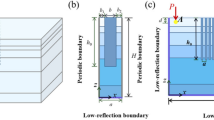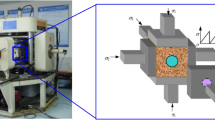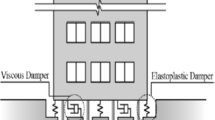Abstract
This paper describes the improvement effect and mechanism of strengthening a liquefied sand foundation using the cross-vibration wing resonance method, through an indoor model test and numerical simulation. The results obtained from the model test showed that a vertical drainage tube was formed during vibration compaction, and finally a crater with a depth of 40 mm and a radius of 150 mm was formed with sloping sides. The sand layer obtained a good improvement effect after resonance vibration, especially in the middle-lower sand deposit. The variation in excess pore water pressure showed different behavior in three stages of the vibration process, and the value after treatment was less than before with a decrease of 18.81%. The vibration energy in the horizontal direction gradually decreased to zero, however the absorption of vibration energy of the soil presented obvious nonuniformity along the depth direction. The results of the numerical simulation were similar to the model test results, including the scope and variation of pore water pressure, and the ground settlement after treatment.
Similar content being viewed by others
References
Adalier K and Elgamal A (2004), “Mitigation of Liquefaction and Associated Ground Deformations by Stone Columns,” Engineering Geology, 72: 275–291.
Boncio P, Amoroso S, Vessia G, Francescone M, Nardone M, Monaco P, Famiani D, Naccio DD, Mercuri A, Manuel MR, Galadini F and Milana G (2018), “Evaluation of Liquefaction Potential in an Intermountain Quaternary Lacustrine Basin (Fucino Basin, Central Italy),” Bulletin of Earthquake Engineering, 16(1): 91–111.
Cao ZZ, Hou LQ, Xu HM and Yuan XM (2010), “Distribution and Characteristics of Gravelly Soil Liquefaction in the Wenchuan M 8.0 Earthquake,” Earthquake Engineering and Engineering Vibration, 9(2): 167–175.
Chen LW, Yuan XM, Cao ZZ, Hou LQ, Sun R, Dong L, Wang WM, Meng FC and Chen HJ (2009), “Liquefaction Macrophenomena in the Great Wenchuan Earthquake,” Earthquake Engineering and Engineering Vibration, 8(2): 219–229.
Cheng Y (2013), “Theory Study and Engineering Application on Vibratory Probe Compaction Method for Ground Improvement at Liquefaction Site,” PhD Dissertation, Southeast University, China.
Cheng Y and Liu SY (2013), “Application of Resonant Vibro-Compaction in Treatment of Liquefiable Sites,” Chinese Journal of Geotechnical Engineering, 35(2): 83–87.
Do J, Heo SB, Yoon YW and Chang I (2017), “Evaluating the Liquefaction Potential of Gravel Soils with Static Experiments and Steady State Approaches,” KSCE Journal of Civil Engineering, 21(3): 642–651.
Du GY, Liu SY, Ren BB and Xie L (2014), “Application of Treatment on Liquefied Foundation using Resonance Compaction Method,” Journal of Engineering Geology, 22(s): 466–469.
Erzin Y and Ecemis N (2015), “The Use of Neural Networks for CPT-Based Liquefaction Screening,” Bulletin of Engineering Geology and the Environment, 74(1): 103–116.
Fattah MY, Al-Mosawi MJ and Al-Ameri AFI (2017), “Stresses and Pore Water Pressure Induced by Machine Foundation on Saturated Sand,” Ocean Engineering, 146: 268–281.
Fattah MY, Salim NM and Haleel RJ (2018a), “Liquefaction Potential of Sandy Soil From Small Laboratory Machine Foundation Model,” International Review of Civil Engineering (I.RE.C.E.), 9(1): 11–19.
Fattah MY, Salim NM and Haleel RJ (2018b), “Effect of Relative Density on Liquefaction Potential of Sandy Soil From Small Laboratory Machine Foundation Model,” International Journal of Science and Research, 7(1): 661–672.
GB/T 50123-2019 (2019), Standard for Geotechnical Testing Method, China: Ministry of Housing and Urban-Rural Development of the People’s Republic of China and State Administation for Market Regulation, approved May 24, 2019.
Hu YX, Zhang YS, Liang JW and Zhang RR (2005), “Recording-Based Identification of Site Liquefaction,” Earthquake Engineering and Engineering Vibration, 4(2): 181–189.
Huang HW, Zhang J and Zhang LM (2012), “Bayesian Network for Characterizing Model Uncertainty of LiquefactionPotential Evaluation Models,” KSCE Journal of Civil Engineering, 16(5): 714–722.
Huang Y and Yu M (2013), “Review of Soil Liquefaction Characteristics During Major Earthquakes of the Twenty-First century,” Natural Hazards, 65(3): 2375–2384.
Ioanna R, Fernando LC, Arezou MFR, Alexandre F and Francois V (2018), “Liquefaction Analysis and Damage Evaluation of Embankment-Type Structures,” Acta Geotechnica. DOI: https://doi.org/10.1007/s11440-018-0631-z.
Ishihara K, Haeri SM, Moinfar AA, Towhata I and Tsujino S (1992), “Geotechnical Aspects of the June 20, 1990 Manjil Earthquake in Iran,” Soils and Foundations, 32(3): 61–78.
JTG/T B02-01-2008 (2008), Guidelines for Seismic Design of Highway Bridges, Ministry of Transport of the People’s Republic of China, Approved October 1, 2008.
Liu SY, Du GY and Miao YH (2008), Cross Vibration Wing, Chinese Patent: ZL 200710020591.9, 2008-12-24.
Liu SY, Du GY, Shao L and Miao YH (2010), Operational Approach on Liquefied Foundation Reinforced Method of Resonance Method, Chinese Patent: 201010119970.5, 2010-07-28.
Massarsch KR and Fellenius BH (2002), “Vibratory Compaction of Coarse-Grained Soils,” Canadian Geotechnical Journal, 39(3): 695–709.
Michael KS, Ricardo D and Ryan P (2010), “CPT-Based Evaluation of Liquefaction and Lateral Spreading in Centrifuge,” Journal of Geotechnical and Geoenvironmental Engineering, 136(10): 1334–1346.
Seed RB, Dickenson SE, Riemer MF, Bray JD, Sitar N, Mitchell JK, Idriss IM, Kayen RE, Kropp A, Hander Jr LF and Power MS (1990), “Preliminary Report on the Principal Geotechnical Aspects of the October 17, 1989, Loma Prieta Earthquake,” Rep. No. UCB/EERC-90/05, Earthquake Engng. Research Center, U. of California, Berkeley, Calif.
Shen MF, Martin JR, Ku CS and Lu YC (2018), “A Case Study of the Effect of Dynamic Compaction on Liquefaction of Reclaimed Ground,” Engineering Geology, 240: 48–61.
Song ZP, Yin JY and Xue Y (2013), “The Global and Sub-Zone Period Characteristics for Large Earthquakes,” Chinese Journal of Geophysics, 56(6): 1868–1876.
Sonmez B, Ulusay R and Sonmez H (2008), “A Study on the Identification of Liquefaction-Induced Failures on Ground Surface Based on the Data from the 1999 Kocaeli and Chi-Chi Earthquakes,” Engineering Geology, 97: 112–125.
Sugito M, Oka F, Yashima A, Furumoto Y and Yamada K (2000), “Time-Dependent Ground Motion Amplification Characteristics at Reclaimed Land after the 1995 Hyogoken Nambu Earthquake,” Engineering Geology, 56: 137–150.
Sun BT and Zhang GX (2018), “Study on Vulnerability Matrices of Masonry Buildings of Mainland of China,” Earthquake Engineering and Engineering Vibration, 17(2): 251–259.
Ulusay R, Aydan Ö, Kumsar H and Sönmez H (2000), “Engineering Geological Characteristics of the 1998 Adana-Ceyhan Earthquake, with Particular Emphasis on Liquefaction Phenomena and the Role of Soil Behaviour,” Bulletin of Engineering Geology and the Environment, 59(2): 99–118.
Xie L (2016), “Study of Treatment on Coastal Liquefiable Ground Using Cross Vibration Wing Resonance Method,” Master’s Dissertation, Southeast University, Nanjing, China.
Zhang G, Robertson PK and Brachman RWI (2002), “Estimating Liquefaction Induced Ground Settlements from CPT for Level Ground,” Canadian Geotechnical Journal, 39(5): 1168–1180.
Zhou FL and Tan P (2018), “Recent Progress and Application on Seismic Isolation Energy Dissipation and Control for Structures in China,” Earthquake Engineering and Engineering Vibration, 17(1): 19–27.
Zhou YG, Sun ZB, Chen J, Chen YM and Chen RP (2017), “Shear Wave Velocity-Based Evaluation and Design of Stone Column Improved Ground for Liquefaction Mitigation,” Earthquake Engineering and Engineering Vibration, 16(2): 247–261.
Acknowledgement
This study was supported by the National Natural Science Foundation of People’s Republic of China under Grant No. 41977241, the Scientific Research Foundation of Graduate School of Southeast University under Grant No. YBPY1981.
Author information
Authors and Affiliations
Corresponding author
Additional information
Supported by
National Natural Science Foundation of People’s Republic of China under Grant No. 41977241, the Scientific Research Foundation of Graduate School of Southeast University under Grant No. YBPY1981
Rights and permissions
About this article
Cite this article
Guangyin, D., Changhui, G., Songyu, L. et al. Resonance vibration approach in soil densification: laboratory experiences and numerical simulation. Earthq. Eng. Eng. Vib. 20, 317–328 (2021). https://doi.org/10.1007/s11803-021-2022-y
Received:
Accepted:
Published:
Issue Date:
DOI: https://doi.org/10.1007/s11803-021-2022-y




